In this issue
Feature Articles
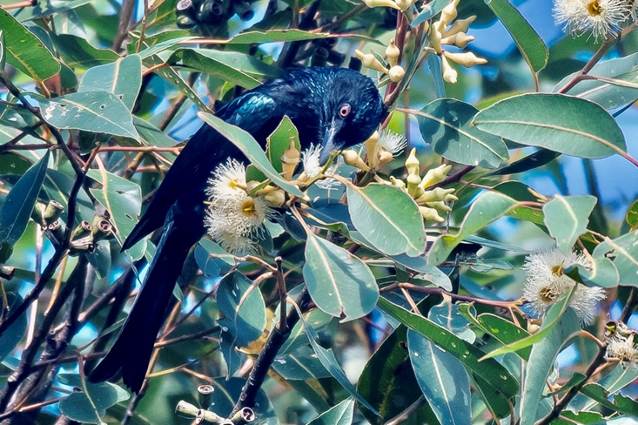
Spangled Drongo Dreaming
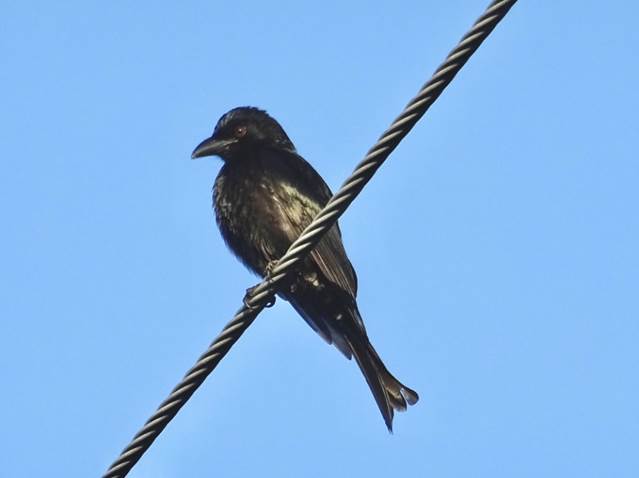
………………………………………………
-Richard Cassels
In Australia, drongo means a stupid person. Wikipedia, citing the Oxford Dictionary and the Cassells’ Dictionary of Slang, says: ‘The word drongo is used in Australian as a mild form of insult meaning “idiot” or “stupid fellow”. This usage derives from an Australian racehorse of the same name (apparently after the Spangled Drongo, Dicrurus bracteatus) in the 1920s that never won despite many places. The word drongo has been frequently used among friends and can be used in a casual or serious tone’.
However, Spangled Drongo is the correct name for a bird that was sitting high in a dead tree, near the water tanks at the Narara Ecovillage one evening last week (photo below). Although the light was poor, its silhouette and behaviour was distinctive.
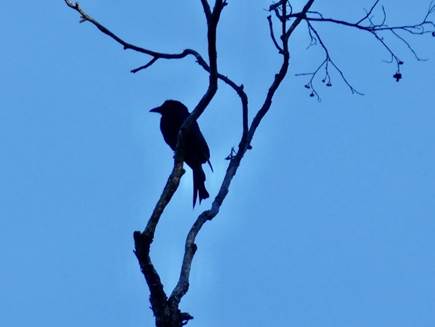
The diagnostic features of Spangled Drongos include: a forked and fishtail tail, long curved beak and habit of perching in a high tree and sallying out and back to catch insects in the air. Adults have amazing red eyes. It is about the same size as the Grey Butcherbird that frequents the ecovillage coffee cart. A drongo, probably this bird, has been seen several times this winter at the ecovillage, which is more than in previous years.
Various species of drongos can be found from Africa to South-east Asia. The Spangled is the only drongo to reach Australia. Spangled refers to shiny spots which can be seen in some lights. They make some harsh metallic calls described by Pizzey and Knight as “like a tight fence-wire being twanged”.
Drongos are common in northern Australia and northern NSW, but some visit southern NSW in winter. So why would they come south in winter?
To put it another way, why would a Queenslander /Byronian visit chilly Narara in winter?
Drongos are noted for catching insects in the air. Being a fairly large bird (compared to common aerial insect catchers like swallows, fantails and robins), the insects must be fairly large to justify the effort. Other similar sized aerial insect catchers are Dollarbirds (Roller family) and they only visit Narara in summer to breed, when insects are much more abundant. There can’t be many large insects flying around Narara in mid winter.
One possible attraction is the nectar or pollen of winter-flowering eucalypts. Tim Lowe’s book “Where Song Began” documents the very large number of Australian birds that feed on nectar (thanks to Nick Carson for pointing this out). Local photographer Laurie Smith got an excellent photo of this happening at McMasters Beach recently (Photo above, courtesy of Laurie Smith).
Another possibility is that they seek out insects in the bark of trees. This is what 3 of the ecovillage Bush Regeneration group recently saw one doing. Michael Morcombe, in his compact Field Guide to Australian Birds, which is well worth reading for its pithy texts, says drongoes “rip into bark for spiders, beetles and other small prey”.
Finally I found this Central Coast Birders Facebook comment by bird guru Alan Morris: “[Drongos] are very omnivorous! Nectar, large insects, cicadas, bees, wasps, and small birds like Silvereyes and Pardalotes!”
So the Spangled Drongo joins a long list of birds that prey on small birds, and an even bigger list of birds that eat almost anything. Not foolish at all.
Footnotes
- The name Drongo comes from Malagasy (the language of Madagascar).
- The most spectacular of all drongos has to be the Greater Racket-tailed Drongo (what a name!) of south and southeast Asia. Photo below of one in Vietnam, courtesy of Greg Miles. What a magnificent tail! NB This is a large bird, 70-80 cms. long.
Many thanks to the members of the Central Coast Birders who continue to give permission to use their outstanding photographs.
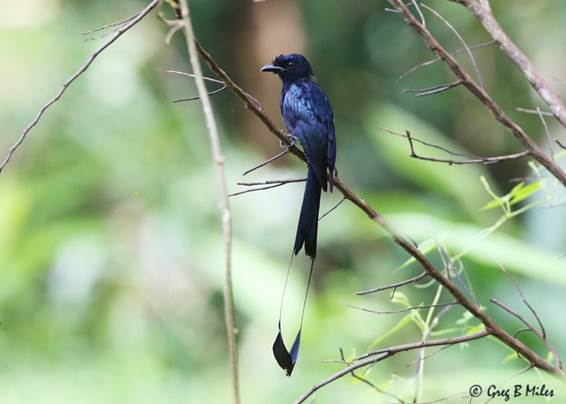
How to Start an Ecovillage

-Tanya Mottl
“Ours was a very long and demanding journey, because it was the first time the cohousing model was introduced and adapted to NZ conditions. It shouldn’t be so challenging for others. It’s for that reason that it feels important to tell the Earthsong story and share our learnings, systems and agreements, to help other projects move faster.”
-Robin Allison, Earthsong Eco-Neighbourhood
Some Narara Ecovillage members & friends recently attended a four-part workshop hosted by founding member of Aukland’s Earthsong Eco-Neighbourhood, architect Robin Allison, “Cohousing from WOW! to HOW”. This online workshop visited ecovillages around the world and then spent time talking about the experiences of Earthsong Eco-Neighbourhood, and it’s almost as good as a face to face workshop.
Robin provided a really helpful walk-through video & a map of her village. Design by and for the community from the outset means there is a good balance between private and community space. Costs were minimised by creating a clear vision and cohesive environmental design. We Australians were excited and inspired by the permaculture design and predominantly pedestrian access for all abilities. The common house was so encouraging of inter-play and inter-action.
Robin used examples from her book, Cohousing for Life, to teach about their community governance and effective decision-making. They use mainly consensus with the Coloured Cards for Discussion and Decision Making. It has served their community well.
My primary take-outs from the workshop:
- Create a clear vision & set up agreements
- Establish a membership model
- Use questionnaires to establish needs/wants & non-negotiables
- Use smaller working groups/circles to focus on specific areas
- Design
- Legal & Finance
- Ongoing education
- Social
- Communications
- Use site contour & models to plan to scale
- Play & celebrate
- Design common elements first
- Standardise the build and customise individual spaces later
- Design for longer term and do the entire project before individuals choose
- Choose a development model that works best for the group; ideally collaboration ONLY after a very clear vision and a team project manager is appointed.
- Bring in help to allow the group to evolve – be that architects and/or facilitators as needed.
As a new member of Narara Ecovillage, it is reassuring to know that much of the groundbreaking social foundational work has already been done, particularly with Sociocracy well-ensconced. While the Stage 2 development is much like Stage 1 with bespoke buildings, individually purchased and designed, Stage 2 will benefit from all the Learnings from Stage 1.
The financial model for each village is different, but both have relied on members with more financial resources lending funds at an agreed interest rate. See the video about Alternative Financial Models with Deb Mohr and Vanessa Huang.
Ecovillage Experience Weekend
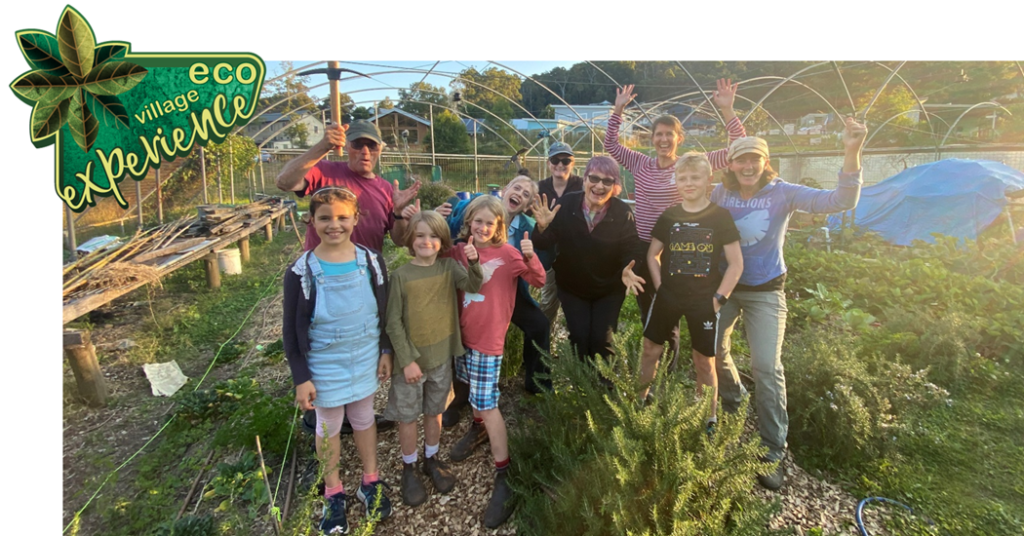
And if you want to learn more & experience Narara Ecovillage in person, register your interest in our immersive Ecovillage Experience Weekend – originally scheduled for October 2021, but now postponed due to COVID (this is one thing you can’t do on Zoom.)
Here is the program, and other information – we expect everything will be the same apart from the dates!
Narara Ecovillage News
Collaborative Living at Narara (CLaN) deadline for registering interest!

-Tanya Mottl
Shared or cohousing is an increasingly popular way to share resources, live a low-carbon life and reduce loneliness. A growing number of older women in particular face homelessness, so it’s small wonder that Sharing with Friends was inundated with over 500 enquiries within days of their affordable cohousing solution in Queensland being featured on the ABC in July this year.
With the release of the IPCC Report on top of the covid lockdown-loneliness pandemic, it’s no surprise that many people of all generations are looking around for realistic ways to share living & reduce their ecological footprint.
CLaN, a group of members & potential members of Narara Ecovillage, is pulling together options for co-owning any of four Special large lots that have been set aside for collaborative housing in the village’s Stage 2 development. The Ecovillage co-op is asking groups to Register their Interest in these larger lots by Sunday 29th August.
This enthusiastic group is exploring how to create a collaborative house (or a couple on adjacent blocks). They’re looking at what makes a flourishing community, with self-governance & decision-making, financing needs & wants, and creating designs that support well-being and include universal design.
Other groups in CLaN are forming for those who may be interested in eventually sharing a dual-occupancy lot, or finding other creative ways of sharing a standard lot, as seen in Stage 1, with primary/secondary residences (granny flats) or even tiny houses. <more>
CLaN meetings are held on Monday, Wednesday and Friday nights by zoom to help neighbours get to know one another. Check out more in the FAQs
We use an online communication channel called Slack to update people who’d like to be involved in learning more about collaborative living.
If you’d like to know more or get involved, contact info@nararaecovillage.com
Goodbye and thanks to our pioneering Project Director, John Talbott (JT)

-Dave Parris
Earlier this month, Nararians said farewell to JT, his wife Sam and son Taran.
The Talbotts are starting another chapter in their life with a return to Findhorn Ecovillage in Scotland. It’s very exciting for them but a bit sad for many of us, particularly as we were unable to provide a suitable send off due to Covid restrictions.
Recently, I had cause to go through my files covering the early history of the Narara Ecovillage. What struck me was the extraordinary effort put in by many people, but particularly the amazing JT, who took on our project with little help in the early days. He started as Project Director in 2012 and after 9 years of effort, look at what has been achieved!
Since JT joined the Sydney Coastal Ecovillage (SCEV) team in early 2012, the following is a list of his achievements (with the help of many) as NEV Project Director:
- raised $4m for Narara Site purchase mid 2012
- lodged 4 DAs in late 2013 with Stage 1 DA approved in August 2014
- Stage 1 major works contract with Robsons Civil approved (July 2016)
- Stage 1 infrastructure completed by end 2017
- Cluster Construction Contract approved Q1 2018
- Cluster Infrastructure complete mid 2020 and occupancy early 2021
Like many of you, I have enjoyed thousands of hours in discussions and meetings involving JT. His motto has been ‘if it’s not fun, it’s not sustainable’ and he has lived this, entertaining us during his nearly 10 years working on the project.
We are hugely indebted to JT, and he will be missed.
Forest Bathing
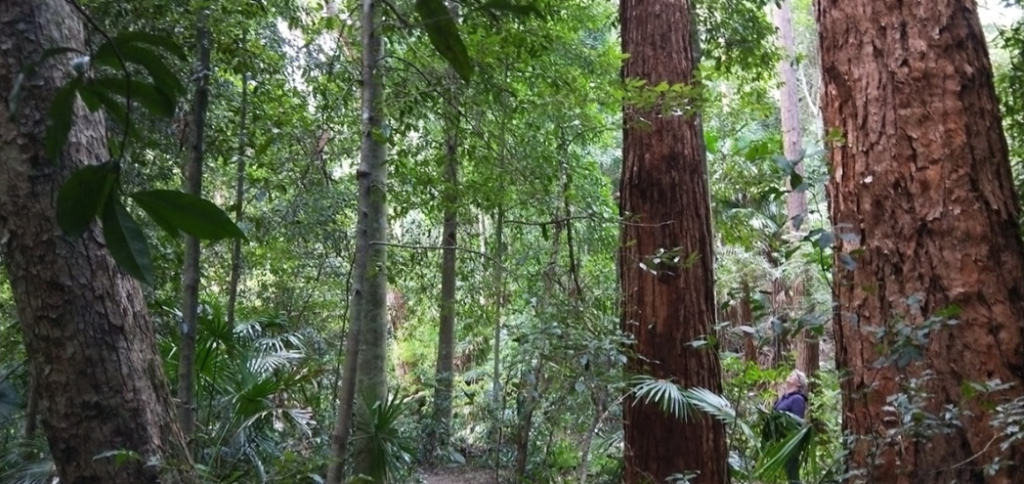
-Lyndall Parris
I have discovered Forest Bathing, and I hear that it’s trendy … so that’s good!
What is forest bathing?
According to the ABC’s Sean O’Brien, it originated in 1980s Japan, and is designed to combat stress (and death) from overwork. It’s all about moving slowly through a forest, slowing down and connecting with nature using your senses.
And I read the following in a book, so I get to test my anecdotal truth: The benefits of Forest Bathing – emotional state and immune system improvement, reduced stress and anxiety and pulse rate, increased relaxation and feeling of well-being, comfort and calmness, reduction in blood pressure after only 15 mins of forest therapy and an increase in feeling refreshed.
How to Forest Bathe
Wander through the forest with your phone switched off and your senses engaged. See colours, shapes, movement, details. Smell the aromas of the forest. Listen for birds, the breeze through the trees, the rustle of leaves underfoot. Touch the trees with all their textures and note the coolness of the creek water.
Thank you covid lockdown, thank you Strickland Forest neighbouring Narara Ecovillage, thank you the new love in my life – Mr Old Tallowwood tree, thank you forest creeks and trails, thank you book: Shinrin- yoku: The Japanese Way of Forest Bathing. I concur with your findings. Within a few minutes’ walk from my home in the ecovillage, I have, on tap, access to this amazing nature medicine … and it is so incredibly sweet.
Events
Narara Ecovillage monthly Open Day: now ONLINE, Sun AUG 29 2021

Brew up a Sunday morning coffee or tea and quiz our Ecovillage members on the topics you’ve always wanted to ask about but didn’t know how.
- When: 10.30am-12pm
- Price: Times are tough for many, so choose to attend free or make a small donation towards our event running costs.
- What:
- Start by meeting Village Founder Lyndall Parris for a short update on the latest milestones in our social and building developments.
- View a short video of the emerging Village, its buildings and the stunning valley where we are located.
Then choose to join the conversation you most want to get the skinny on…
- Family living at Narara: what’s it like to raise children there, school options, support and more
- Legal and Finance issues: Get the facts on the ins and outs of financing a building and where to find answers to your legal questions. What does it cost to live in the community and what do I get for this?
- Sustainable Building: Technical and material queries and design experience in our diverse buildings to date. What do you want to know, and how can we make it possible?
- Culture and Community: Ask how we make these words a reality to support our residents and bring us together.
- Collaborative Living: Meet and quiz our collaborative housing pioneers. What does it look like, ownership, financial and legal questions and who could I share this idea with? Is this a way to live in community for you?
- Food production in the Village: Ask our veggie growing, permaculture, chicken-raising expert amateurs what’s on offer and how to get involved.
This online session is all about YOU and anything you need to know to help you turn dreams of Ecovillage living a step closer to reality.
There remain only a very few lots unaccounted-for in our Stage 2 development so the window is closing for the last members to own and move into this successful Ecovillage community.
Peeling the Onion on Sociocracy – online in September

-Tanya Mottl
During my slow 18 month journey to joining Narara Ecovillage, I’ve had the chance to learn a bit about sociocracy: attending the Taster sessions at Open Days and observing actual meetings as a “fishbowler”, to see how sociocracy works in a real, complex organisation.
I’ve just finished the 14 week online Ecovillage Design Education program, and was pleased that my weekly practice group used Sociocracy so well, setting up group agreements, sharing responsibilities and using shared leadership principles.
I’ve also been using sociocracy principles in meetings
with Global
Ecovillage Network Australia.
So when the CLaN group met recently to share learnings from Robin Allison’s
Earthsong Eco Neighbourhood, it was delightful when a village member with
sociocracy expertise spontaneously helped us to practice using a Sociocratic
process. It was gentle, inclusive, engaging, timely and fun practising
new skills.
And when I had the opportunity to volunteer on the online Sociocracy workshops in September with village member John Shiel, I jumped in to learn with him! It’s been a great process and I’ve also got to better know other village members as a side benefit.
So I’m really looking forward to diving deeper in this workshop series, run by Narara Ecovillage Board member and Australia’s leading Sociocracy consultant Gina Price.

Peeling the Onion on Sociocracy
Learn elements of the Sociocratic Circle Method and how they work together for whole system intelligence.
- Aim and Domain – Friday 17 September 7-8.30pm
- Leading and Measuring – Friday 24 September 7-9pm
- Election by Consent – Sunday 26th September 2-5pm
Find out more about the workshops here
Do a Thing a Day
Our Most Powerful Action – tell them what you think
“Do your little bit of good where you are; it’s those little bits of good put together that overwhelm the world.”
–Desmond Tutu cited in this article
“Keep going, have faith, have hope… be very careful of the doomsday, nihilistic narrative that is promoted by the fossil fuel industry … Frame this moment as an opportunity…an enormous chance to restructure our economy and lives, to regenerate all sorts of ecosystems and social systems… to move to a more ecological society”
–Damon Gameau, speaking on ABC TV “The Drum”, 11 August 2021.

-Suzie Brown
While many of us do all we can to reduce our carbon footprint, you may have read the alarming findings of the latest IPCC report on climate change and wondered what more can be done?
Right now we have a powerful opportunity to push the Australian government to improve its climate response because there’s an election coming soon (due by May 2022). The major international climate meeting, COP 26, is also happening this November in Glasgow which will put the Australian government under immense pressure to commit to stronger targets, as our major trading partners have done.
Your Federal Member of Parliament needs to hear from you that getting voted back in at the next Federal election depends on their party taking serious action on climate change.
Please write a letter or email to your Federal MP asking them to push for strong commitments to cut Australia’s emissions and phase out fossil fuels. (If your MP is from the Greens or is a pro-climate independent such as Zali Steggall, then instead please write to the Liberal, National or ALP Senators for your state.)
Tell them that your vote will depend on this – and that “everyone I know in this electorate thinks that the government is not doing enough on climate change”. This is the key message they need to hear!
- Here is a handy tool to find your Federal MP’s contact details
- Senators you can write to are listed here (choose any for your state)
Some points you may want to include (statistics from the Climate Council):
- The latest IPCC report on climate change came out recently: it’s the most important climate science update for almost a decade and shows there is a narrow path to avoiding climate catastrophe, but only through immediate, deep and sustained emissions reductions. This may be our final warning.
- I’m deeply worried about what the report says about our future and for my kids/grandkids etc – and I am worried about the impacts we already have, such as bushfires, floods and extreme heat in Australia and overseas. Every day we delay makes the problem worse.
- The report confirmed that the Paris agreement’s 1.5C warming limit is not lost, and with strong global action, we can still achieve it.
- Australia is a significant player worldwide. We are the 16th largest emitter of CO2 out of more than 200 countries, and our per capita emissions are in the top 10 globally. When our exported fossil fuels are included, we rank 5th in the world in terms of greenhouse gas emissions. This means we bear significant international responsibility in the global effort to stop climate breakdown.
- Based on the latest science, Australia needs to reduce its emissions by 75% below 2005 levels by 2030, and achieve net zero emissions by 2035.
- All of this can be achieved with existing technology – it just needs our government to prioritise Australians over big business.
- If you’ve already written to a representative and received their standard reply (about how much great stuff they are doing and how their targets are adequate), here’s a great post from the ARRCC debunking those myths and messages – which is great material for your second letter!
Finally here’s a clear list of 10 actions Australia needs to do, written by a local climate scientist
- 1. Electrify everything – energy, transport and manufacturing.
- 2. Power it all from renewables, obviously.
- 3. Remove all fossil fuel subsidies (more than $10bn from taxpayers per year) and use this money to transform the grid.
- 4. Stop, or at least greatly reduce, eating the products of methane-belching cows, the farming of which is also responsible for most land-clearing in Australia.
- 5. Plant trees – still the best way to draw down CO2.
- 6. Stop buying so much stuff – everything has a carbon cost.
- 7. Reuse, retain, recycle. You know the drill.
- 8. Move your money out of banks, insurance companies and superannuation funds that invest in fossil fuels – it only takes a few clicks.
- 9. Give your time, your talent or your treasure to organisations that are fighting the good fight – there is power in the collective.
- 10. And most of all, ask yourself: is my elected representative threatening the lives of my children and grandchildren, either by actively blocking climate action, or by simply delaying in the hope that some uninvented technology will fall from sky? You can help save the world with a pencil. Vote. Them. Out.
“I’m deeply worried for my young daughter’s future – and for all of our futures – as I see heatwaves, floods, bushfires and storms accelerating across the globe. I’ve done all I can do to cut my own carbon emissions – I desperately want to see national leadership to stop the use of fossil fuels and get Australia on the fast track to zero net emissions.”
-Guy Dutson, Narara Ecovillage member
Watch David Suzuki’s <3 minute video: “We are the Air”

Visit Narara Ecovillage Coffee Cart: Tuesdays to Saturdays till around 2pm

-Lyndall Parris
Candy and her son Dave, masters of the Narara Ecovillage Coffee Cart, are making berry muffins daily during lockdown. We can offer these to people from our LGA, but only mouth-watering thoughts for our friends from further afield right now.
If Judy Wicks’ food story becomes our trajectory, our foray into selling coffee and these yummie delights will be just the beginning. I first met Judy in 2008, when she was visiting Sydney from the US, telling her story and introducing us to BALLE – the Business Alliance for Local Living Economics.
With a couple of kids at foot, Judy started making muffins at night and selling them by day from a small outlet near the university in Philadelphia. She eventually developed the White Dog Café, a 200-seat, top American restaurant featuring fresh local food and growing a national reputation for community engagement, environmental stewardship and responsible business practices.
Look out world here we come!


